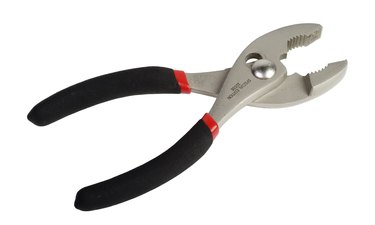Things You'll Need
Work gloves
Screwdriver set
Heat-resistant duct tape
Register air filters
Pliers
File set
Electric drill (optional)
Screws (optional)

Noise caused by heat registers not only interrupts sleep, but can also negatively impact work and/or social activities. Register-related noise is typically an indication that something is wrong with the register or vent opening. As a result, making heating registers quiet in a home or office requires a thorough check of both of these heating system elements to determine if the noise is due to a loose or broken register piece, vent materials that are rubbing against the register and/or a register that doesn't fit securely into the vent opening.
Step 1
Grip the heat register and move it side-so-side while in the vent to see if it fits securely in the vent opening or has any loose screws. Tighten any loose screws and turn on the heat to test for noise. If your model doesn't have screws, appears to be loose in the vent opening and/or continues to make noise, go to Step 2.
Video of the Day
Step 2
Remove the register from the vent and shake it to try to replicate the noise. If the register is the source and has loose or broken shutters in the damper box beneath the register grate, or a loose damper box control (button, lever or wheel) on top of the grate, go to Step 3. If the register isn't the source and/or the register had an improper vent opening fit when you tested it, go to Step 5.
Step 3
Secure the shutters in a semi-to-fully opened or closed position to stop the noise. Apply one end of a strip of heat-resistant duct tape to the shutters and/or damper box control under the grate and the other end to a box side to hold the shutters in place in a desired position. If you don't want to use tape, insert an air filter into the damper box between the shutters and grate to reduce vibrations caused by loose shutters and then position the shutters.
Step 4
Shake the register to test for noise. If you don't hear noise, return it to the vent and test the heat to see if any more noises occur. If you hear additional noise that seems unrelated to the shutters or damper box, remove the register from the vent and go to Step 5.
Step 5
Run a gloved hand along the inside top of the air vent opening to feel for screws, metal vent pieces or wood sticking out at odd angles. Use your pliers to bend any materials that you find against the vent walls or a file to remove the material ends sticking out. Place the register back in the vent when finished and test the heat. If you still hear noise, go to Step 6.
Step 6
Correct a loose or poorly fitted register that moves side-to-side or up-and-down when exposed to heat pressure. Drill holes at the center of each end of a rectangular register or center of each side of a square register and then screw the register into the floor or wall through the holes to secure it in place.
Tip
If you don't want to secure your register by drilling into floorboards or walls, consult with a heating ventilation expert to determine the best way to correct the noise.
Warning
Always confirm with an electrician the location of electrical wiring before drilling to protect against electrocuting yourself.
Video of the Day